The Noble Carp?
It probably doesn’t occur to most people to view a fish as a symbol of heroic qualities, unless maybe it’s a whale or a shark. In Japan, the carp (koi in Japanese) is a symbol of courage, persistence, success, and strength of character. These traits have been accrued over the centuries, based partly on the fish’s ability to swim upriver (like salmon in the Western hemisphere) and up waterfalls in order to mate. This bravery has been likened to that of the samurai. I find it fascinating that such a simple life form could inspire such noble symbolism.
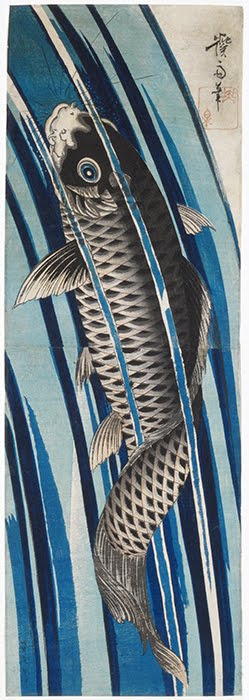 |
| Keisai Eisen (1790–1848), Carp, 1830. Color woodcut on paper, 28 3/8" x 9 13/16" (72 x 25 cm). © Museum of Fine Arts, Houston. (MFH-368) |
Late Edo period ukiyo-e artist Keisai Eisen is primarily known for his landscapes and nature scenes in woodcut print format. His prints of beautiful women (bijin-ga) are among the most baroque of the late stage of the “first ukiyo-e” period. He also did numerous depictions of carp. The carp jumping the waterfall to get to its mating place is part of a Chinese legend (“liyutiaolongmen”) in which few carp are brave enough to make the final leap up a certain waterfall after swimming upriver. Those who are able to leap over the mythical “dragon gate” at the top of the falls are transformed into dragons. I guess this covers the traits of persistence and success in achieving goals.
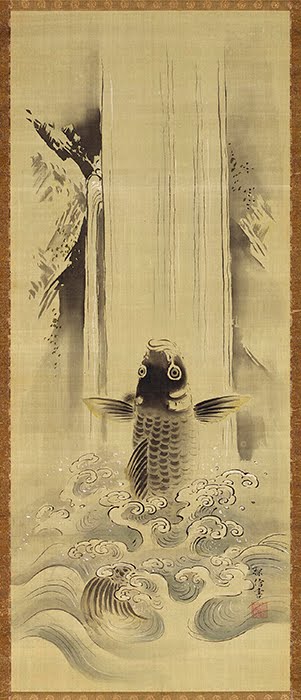 |
| Kanō Tanshin Morimasa (1653–1718), Carp Ascending a Waterfall, 1668. Ink and color on silk hanging scroll, 39 7/16" x 16 1/8" (100.2 x 41 cm). © Museum of Fine Arts, Boston. (MFAB-788) |
Morimasa was the son of Kanō Tanyu. The conservative Kanō School was a group of painters who preferred the Chinese style of painting and traditional subject matter of nature and landscapes, compared to the genre scenes and entertainment figures of the ukiyo-e artists. They were the preferred artists of the nobility and the shoguns’ court. Here Morimasa depicts the timeless subject of the brave carp leaping up the waterfall. Sometimes these depictions are almost anthropomorphic as the fish are depicted with fins flailing, eyes bulging and mouth open as if gasping for air.
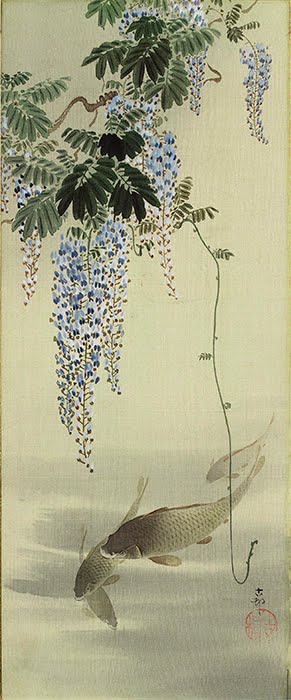 |
| Ohara Koson (1878–1945), Carp and Wisteria. Ink and color on silk, 15 15/16" x 6 9/16" (40.5 x 16.7 cm). © Museum of Fine Arts, Boston. (MFAB-1041) |
After being forcibly opened to the West in the 1850s, Japanese art took two avenues, artists who were influenced by and sometimes adapted Western painting (yo-ga or Western pictures) and artists who insisted on maintaining Japanese traditions in art, “nihon-ga” or Japanese pictures. Koson is one of those artists who combined both strains. He has painted a traditional theme with a Western-style realism and a logical suggestion of depth. Here two carp are linked with wisteria, a flower that blooms in the late spring. As such the wisteria is a symbol of fertility. Carp are also symbols of abundance because they produce so many eggs. Two carp together symbolize a happy marriage.
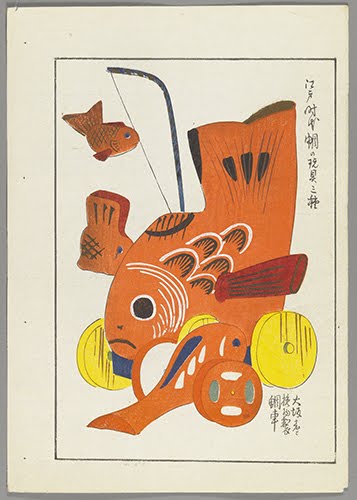 |
| Shimizu Seifu (1851–1913), Carp Toy on Wheels, from a ten volume series A Child’s Friends,” published 1891–1923. Color woodcut on paper, 8" x 5 5/8" (20.3 x 14.3 cm). © Brooklyn Museum. (BMA-3681) |
Even Japanese toys celebrate the noble carp.
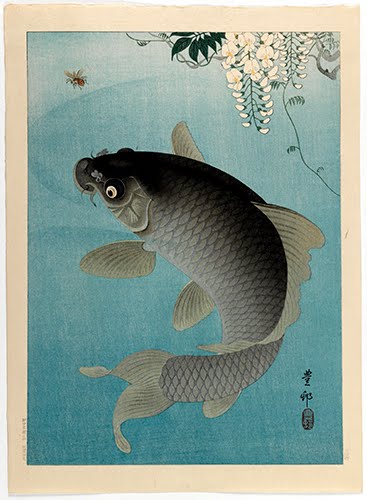 |
| Ohara Shoson (1875–1949), Carp Beneath Wisteria, ca. 1935. Color woodcut on paper, 14 ¾" x 10 5/8" (37.5 x 27 cm). © Brooklyn Museum. (BMA-2641) |
I included a second Ohara school artist because this is just such a beeeeautiful print. It never fails to impress me the nuances that the woodblock printers achieve with color, and the fidelity of registration within the lines! The carp is not only thought to be brave like a samurai in its persistence in swimming against the current, but also when caught, it is said that the carp lies still under the knife, much like the samurai facing a sword.
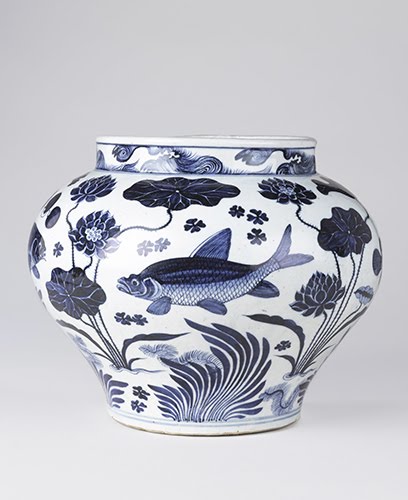 |
| China, Wine jar with carp and aquatic plant motif, 1300s. Porcelain with underglaze blue cobalt decoration, 11 15/16" x 13 3/4" (30.3 x 34.9 cm). © Brooklyn Museum. (BMA-4947) |
In China, the carp is called li pronounced the same as the character for “profit,” and the character for “strength” or “power.” The “Dragon’s Gate” myth about the carp originated in relation to a large waterfall on the Yellow River.
Correlations to Davis Programs: Explorations in Art Grade 1: 4.connections; Explorations in Art Grade 2: 3.14; Explorations in Art Grade 3: 5.25, 5.25-26 studio, 6.35-36 studio; Explorations in Art Grade 4: 4.20, 4.21-22 studio; Explorations in Art Grade 5: 4.22, 4.21-22 studio, 4.connections; Explorations in Art Grade 6: 2.12; A Community Connection: 6.2, 8.2; A Global Pursuit: 7.5; Experience Clay: 4, 5; Experience Printmaking: 3, 4; Experience Painting: 4; The Visual Experience: 3.5, 9.3, 9.4, 13.4, 13.5; Discovering Art History: 2.2, 4.3, 4.4


Comments